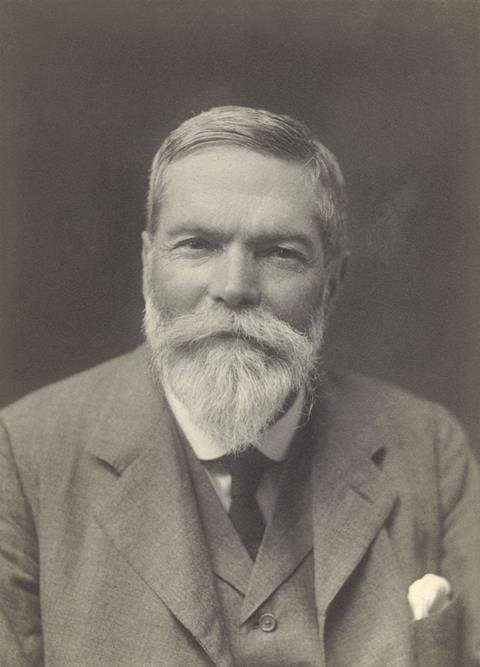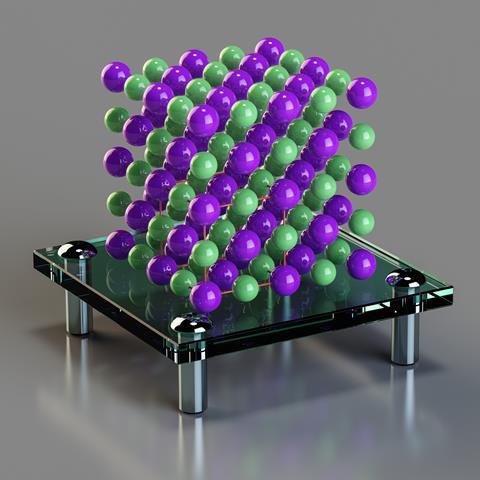A three-dimensional picture enlivens a thousand words

One of my favourite websites is the Internet Archive, a marvellous repository of old books, movies and audio recordings. As I prepare Classic Kit each month I regularly find myself grazing my way through their collection of textbooks and monographs. What is striking is the sheer aridity of old chemistry texts, featuring just a few pictures of apparatus. It is small wonder that chemistry lecturers required huge wooden benches festooned with apparatus and chemicals to bring alive what was then a pretty abstract subject.
Our textbooks today are awash with photos, diagrams and visualisations. So what are the key images that really kickstarted the process of making the invisible atomic world almost tangible?
When John Dalton reignited the dormant atomic theory at the beginning of the 19th century, he accompanied his hypothesis with a set of rather cryptic symbols – circles with lines, crosses and stripes – to distinguish one atom from another.
Over half a century later, the structural theory of chemistry would start to emerge. At the end of the 1850s two chemists, Archibald Scott Couper, a Scott studying in Paris with Adolphe Wurtz and, controversially, August Kekulé in Heidelberg, Germany, would start using structural notations in their proposals about the connectivity of carbon atoms. Alexander Butlerov working in Kazan in Russia would state explicitly that each organic compound was distinguished by its structure.
Then in 1861, in an astonishing creative leap Josef Loschmidt speculated on the structures of molecules in a book entitled Chemische Studien. Like Dalton, Loschmidt represents the atoms as circles, but of different sizes. Where two circles touch there is bonding; there are also hexagonal representations of benzene and its derivatives. They are space-filling models a century ahead of their time.
Picture this
But Loschmidt’s ideas were mostly overlooked. If Kekulé had seen the diagrams before he published a hexagonal structure for benzene, he gave his contemporary no credit. And even as Jacobus Henricus van’t Hoff and Joseph Achille Le Bel made their proposals about tetrahedral carbon in 1874, followed soon after by Albert Ladenburg’s brilliant, but sadly incorrect, prismatic structures for molecules like benzene and naphthalene, journals and textbooks continued to keep chemical diagrams to a minimum.
For me, the crucial turning point in the use of three-dimensional pictures of the chemical world comes from an independently wealthy semi-amateur scientist, William Barlow, who had turned his mind to trying to understand the nature of crystals.
Born into the family of an entrepreneurial builder in North London, Barlow was educated privately, developing a passion for mathematics and science more widely. He also learned carpentry and cabinet-making, skills that he would use throughout his life. His informal training was probably responsible for him failing the London University Matriculation exams – he is said to have ignored the easy questions and focused on the difficult bits, some of which he only solved hours later while sitting on the bus home. He then took classes that the City and Guilds Technical College where he was taught by the chemist Henry Armstrong and the optical crystallographer William Pope, both of whom would be mentors and then close friends.
When his father died in 1875 he left enough money to make Barlow the master of his own time. It gave him the leisure to think about crystals. He took his wife and children on a long trip to Germany where he met and befriended Paul Groth, one of the ‘big beasts’ of German crystallography who was developing Auguste Bravais’ ideas about lattices.
On his return to London, Barlow began to attend meetings of the British Association and other scientific societies. In 1883 he wrote up his ideas about the constitution of crystals based on the packing of spheres, an idea that had started with Kepler in 1611. Barlow stacked the spheres in the arrangements that we now call body and face-centred cubic, and made the first suggestion of hexagonal packing. He also proposed structures for salts with the now familiar alternation of ions. The two short papers, published in Nature, were accompanied by diagrams that would not look out of place in a modern undergraduate text; the spheres have a three-dimensional solidity that cannot be unseen. Barlow took some flak because six-coordinate sodiums and chlorides seemed to violate the notion of ‘the molecule’ and ideas about valence. Twenty years later Barlow’s proposals would be vindicated by the Braggs’ crystal structures.

Over the next few years, Barlow mused on how molecules could pack in three dimensions. His methods were deeply unconventional, helping himself in his thinking by building models. Wanting to get away from the idea of spherical atoms, Barlow used dolls’ hands or gloves to represent the contents of his unit cells. His work led him to propose that there were 230 possible arrangements, arriving at his conclusion only a couple of years after Arthur Schoenflies and Evgraf Fedorov had each reached the same conclusion by rigorous mathematical methods.
By the time Barlow died in 1934 descendants of his diagrams appeared not only in academic monographs, but in undergraduate textbooks too. If you don’t believe me, head to the Internet Archive and have a look.
Acknowledgments
Thanks to Rob Palgrave for the inspiration and the late Alfred Bader for bringing Loschmidt to my attention many years ago
References
1 W Barlow, Nature, 1883, 29, 186 (DOI: 10.1038/029186a0)
2 W Barlow, Nature, 1883, 29, 205 (DOI: 10.1038/029205a0)












No comments yet